-
(effect of peptide architecture on the self-assembly properties of tripeptide based anionic surfactants issued from two different peptide sequences: ala-ala-val and ala-pro-val in aqueous media (ph 7.4
جزئیات بیشتر مقاله- تاریخ ارائه: 1392/07/24
- تاریخ انتشار در تی پی بین: 1392/07/24
- تعداد بازدید: 1290
- تعداد پرسش و پاسخ ها: 0
- شماره تماس دبیرخانه رویداد: -
structurally different tripeptide based surfactants issued from two different peptide sequences: ala-ala-val (i) and ala-pro-val (ii) were synthesized and their self assembly properties were characterized using various physicochemical experiments (tensiometry, fluorimetry, anisotropy, fluorescence lifetime, dls, cd, tem) in aqueous media (ph 7.4). the results reveal that, architectural change of the tripeptide sequence on the surfactant backbone affects their self assembly properties remarkably. the replacement of alanine by proline residue in the middle of the tripeptide sequence affects the intermolecular h-bonding interaction operative at the peptide segment (β-sheet for i and random coil for ii) which seemingly affects the molecular aggregation as well as the self assembly properties of the surfactants. such architectural change at the peptidic level induces a larger curvature that results to a micellar type aggregates for ii whereas, a β-sheet type interaction prevailing in i does not affect much towards the packing of the surfactants tails rather helps in formation of elongated micelles. micellar growth was also found to be more pronounced in case of i. higher cmc values and lower aggregation number for ii compared to i also describes that an increase in hydrophilic character takes place in ii. formation of micellar aggregates in presence or absence of h-bonding network suggest that hydrophobic effect is the driving force behind the self assembly process but not the h-bonding interaction, however the physicochemical properties of the self assemblies are affected by h-bonding interaction of the peptide segment.
مقالات جدیدترین رویدادها
-
استفاده از تحلیل اهمیت-عملکرد در ارائه الگوی مدیریت خلاقیت سازمانی و ارائه راهکار جهت بهبود
-
بررسی تاثیر ارزش وجوه نقد مازاد بر ساختار سرمایه شرکت های پذیرفته شده در بورس اوراق بهادار تهران
-
بررسی تأثیر سطح افشای ریسک بر قرارداد بدهی شرکت های پذیرفته شده در بورس اوراق بهادار تهران
-
بررسی تأثیر رتبه بندی اعتباری مبتنی بر مدل امتیاز بازار نوظهور بر نقد شوندگی سهام با تأکید بر خصوصی سازی شرکت ها
-
تأثیر آمیخته بازاریابی پوشاک ایرانی بر تصویر ذهنی مشتری پوشاک ایرانی (هاکوپیان)
-
بازاریابی حسی: رویکرد نوین در صنعت بازاریابی
-
using jointly distributed random variables method to determination of saturated sand liquefaction reliability
-
ارائه مدل شبیه سازی برای بهینه سازی گردش مدارک کنترل پروژه
-
میوفیبروبلاستومای عقده لنفاوی در بازوی پسر بچه 13 ساله ”گزارش یک مورد“
-
برآورد بارمالی حوادث منجر به فوت در پروژه های ساختمانی شهر تهران در سال آتی
مقالات جدیدترین ژورنال ها
-
مدیریت و بررسی افسردگی دانش آموزان دختر مقطع متوسطه دوم در دروان کرونا در شهرستان دزفول
-
مدیریت و بررسی خرد سیاسی در اندیشه ی فردوسی در ادب ایران
-
واکاوی و مدیریت توصیفی قلمدان(جاکلیدی)ضریح در موزه آستان قدس رضوی
-
بررسی تاثیر خلاقیت، دانش و انگیزه کارکنان بر پیشنهادات نوآورانه کارکنان ( مورد مطالعه: هتل های 3 و 4 ستاره استان کرمان)
-
بررسی تاثیر کیفیت سیستم های اطلاعاتی بر تصمیم گیری موفق در شرکتهای تولیدی استان اصفهان (مورد مطالعه: مدیران شرکتهای تولیدی استان اصفهان)
-
تحلیل حکم حکومتی در فقه سیاسی
-
پنهان کاری در انتقال داده های پزشکی ایمن برای سیستم های مراقبت بهداشتی مبتنی بر iot
-
ارتباط کوته بینی مدیران با نوسانات سود و سهامداران عمده در شرکت های پذیرفته شده در بورس اوراق بهادار تهران
-
ارائه الگوی مدیریت استعداد در نهاجا
-
utilization of palm oil fuel ash and eggshell powder as partial cement replacement - a review




سوال خود را در مورد این مقاله مطرح نمایید :